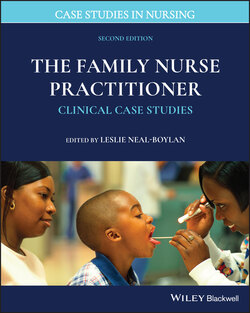Читать книгу The Family Nurse Practitioner - Группа авторов - Страница 39
ОглавлениеCase 4.8 Nightmares
By Mikki Meadows‐Oliver, PhD, RN, FAAN
SUBJECTIVE
Six‐year‐old Daniel presents to the office with his mother, Donna, with complaints of frequent nightmares. Donna states that Daniel will be asleep and will suddenly sit upright with his eyes open and start to scream loudly. She says that Daniel looks terrified and that he sweats and breathes fast during these episodes. Donna says that while Daniel is screaming, she is unable to wake, console, or comfort him. The screaming episodes typically last about 5 minutes each and happen 3–4 times weekly. Donna states that after the screaming stops, Daniel returns to sleep and does not remember the screaming episodes when he awakens in the morning. Daniel does not have any problems falling asleep. He sleeps approximately 10 hours each night but does not have a set bedtime or a regular bedtime routine. He sleeps in his own bed and shares a room with his younger brother.
Diet: Balanced diet with sufficient sources of dairy, protein, fruits, and vegetables.
Elimination: Daniel is voiding well with no complaints of dysuria. He has 1 bowel movement daily and denies constipation or diarrhea.
Past medical history: Born via vaginal birth at 40 weeks’ gestation. The mother’s pregnancy was without problems. She had no infections, falls, or known exposures to environmental hazards. She did not drink alcohol, take prescription medication (other than prenatal vitamins), use tobacco products, or use illicit drugs. There were no problems for Daniel during his neonatal period. Since birth, he has had no injuries or illnesses requiring visits to the emergency department. He has no chronic illnesses.
Family history: Daniel’s mother (27 years old) and father (26 years old) are both healthy and have no history of chronic medical conditions. His 3‐year‐old sibling also has no history of chronic medical conditions. His maternal grandmother (54 years old) has a history of asthma. His maternal grandfather (55 years old) has a history of high cholesterol. Daniel’s paternal grandmother (52 years old) has a history of hypertension. His paternal grandfather (52 years old) has a history of hypertension and had a stroke at age 47 years.
Social history: Daniel lives at home with his mother, paternal grandmother, paternal uncle, and his younger brother (3 years old). His mother works as a restaurant waitress. Daniel’s father is incarcerated. The family has no pets. There are no smokers in the home.
Medications: Daniel is not currently taking any over‐the‐counter, prescription, or herbal medications. He has no known allergies to medication, food, or the environment. He is up to date for required immunizations.
OBJECTIVE
General: Alert, cooperative, and active; appears well hydrated and well nourished.
Vital signs: Weight in the office was 28 kg. Temperature was 36.9°C (temporal).
HEENT: Normocephalic. Red reflexes are present bilaterally; and pupils are equal, round, and reactive to light. There is no ocular discharge noted; external ear reveals that the pinnae are normal and that there is no tenderness to touch on the external ear. On otoscopic examination, the tympanic membranes are gray bilaterally, in normal position, with positive light reflexes. Bony landmarks are visible, and there is no fluid noted behind the tympanic membranes. Both nostrils are patent. There is no nasal discharge and no nasal flaring. Daniel’s mucous membranes were noted to be moist when examining his oropharynx. There is no evidence of visible caries or other lesions in the oral cavity.
Neck: Supple and able to move in all directions without resistance. There was no cervical lymphadenopathy present.
Skin: Clear of lesions; no cyanosis of his skin, lips, or nails; no diaphoresis noted; and there is elastic recoil.
Respiratory: Respiratory rate is 20 breaths per minute, and the lungs are clear to auscultation in all lobes. There is good air entry, and no retractions or grunting are noted on examination. No deformities of the thoracic cage are noted.
Cardiac: Heart rate is 102 beats per minute with a regular rhythm. There is no murmur noted upon auscultation.
Abdomen: Normoactive bowel sounds are present throughout. Soft and nontender. No evidence of hepatosplenomegaly.
Genitourinary: Normal circumcised male genitalia without erythema or lesions; testes are descended bilaterally.
Neuromusculoskeletal: Good tone and full range of motion in all extremities. Extremities are warm and well perfused. Capillary refill is less than 2 seconds. Spine is straight.
CRITICAL THINKING
1 Which diagnostic or imaging studies should be considered to assist with or confirm the diagnosis?___EEG (electroencephalogram)___Polysomnography___MRI (magnetic resonance imaging)___CT (computed tomography) scan___Skull radiograph
2 What is the most likely differential diagnosis and why?___Nightmares___Nocturnal seizures___Night terrors___Sleepwalking (somnambulism)
3 What is the plan for treatment, referral, and follow‐up care?
4 Does this patient’s psychosocial history affect how you might treat this case?
5 What if the patient lived in a rural setting?
6 Are there any demographic characteristics that might affect this case?
NOTE: The author would like to acknowledge the contribution of Allison Grady, MSN, RN to this case in the first edition of this book.
